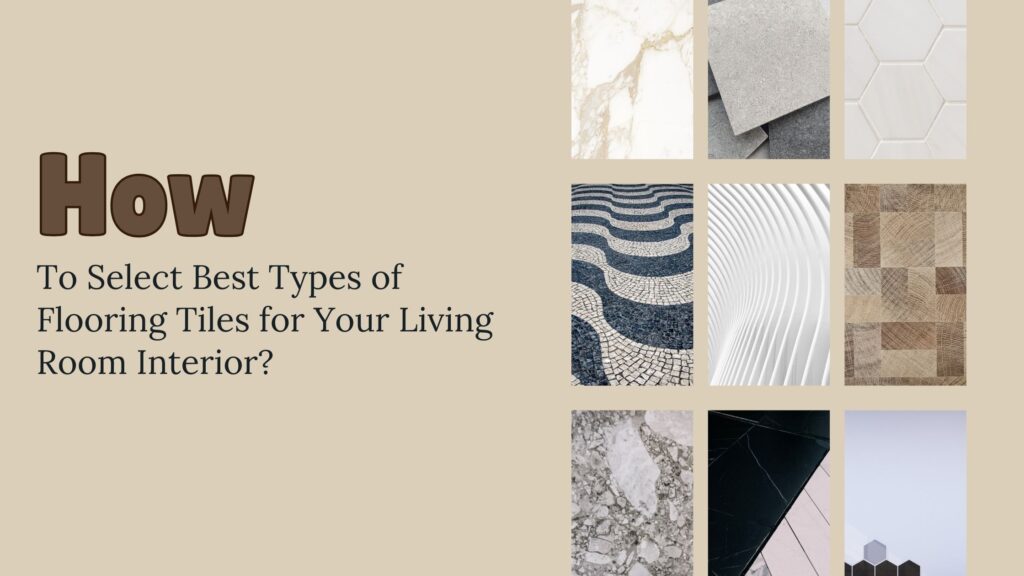A floor contributes significantly to the look of a living room, its usability, and the extent to which it ought to be durable. There are too many flooring materials that people can use these days, so selecting the most appropriate type of floor tile to use in a living room is not easy. The best flooring tiles would need to meet the room’s sophistication, comfort, and durability.
Here, we will enlighten you on all the kinds of floor tiles, materials, and finishes and explain how to select the best superior flooring for your sitting room furniture. If you are ready to adhere to types of wood flooring, types of marble flooring, or types of flooring in India, then this blog will guide you to select the best one.
Why Floor Tiles are so Significant in Living Room Decor?
The living room is a house’s nucleus. It is where the people living in a residence gather, friends and acquaintances are greeted, and day-to-day existence is spent. It is oftentimes the zone people walk into initially as they are entering a dwelling, and as such, it is a defining room where one must instill style and character.
The proper floor choice, including different types of flooring, can be a difference maker in the texture, coordinating the furniture, walls, and design elements for an overall look. Apart from appearances, the floor in this room not only should be nice to look at but should also be able to withstand regular use and work and remain beautiful for years to come.
Some of the most important things to remember when choosing floor tiles for a living room are:
1. Beauty
The texture, design, and appearance of the tiles should be aesthetically pleasing to the overall design of your house. From the neat, bare appearance to a snug, nostalgic feel, the floor establishes the atmosphere of the remaining room’s ambiance. A properly selected tile design will make the room appear larger and in better proportion to the rest of the entire design.
2. Durability
The floor should be able to support furniture weight, foot traffic, and the possibility of spills. Materials used in high-traffic areas should not scratch or stain in order to be durable. Select tiles based on the family’s needs, especially where there are pets or children, so that wear and tear will not be a problem in the future.
3. Maintenance Needs
There are more and less maintenance tiles. Go for ease of cleaning and maintenance. Gloss tiles, for example, need to be constantly cleaned to remove smudges and footprints, while matte and textured finishes will hide dust and small blemishes. A maintenance tile is effort-saving and time-saving in the long term.
4. Safety and Comfort
Living rooms are where one walks barefoot, relaxes, or plays, so choosing a floor that’s a compromise between comfort and safety is required. Anti-slip coats or textured surfaces will prevent any accidents and can be quite helpful in homes where there are children or elderly.
A high-quality floor tile can make a living room a comfortable, classy, and practical room. Taking time to select the ideal material makes your floor a durable and lasting element of your house.
If you also want to create a stylish and comfortable home, check out Single Floor House Design: A Perfect Match of Comfort and Style — it’s packed with great ideas to make your space look and feel amazing.
Other Living Room Flooring Choices
There are numerous types to choose from, and every type has advantages and disadvantages. There are different types of floor tiles, but the most common types are:
1. Ceramic Floor Tiles
Ceramic floor tiles are popular living room floor tiles since they are affordable, durable, and come in a range of designs.
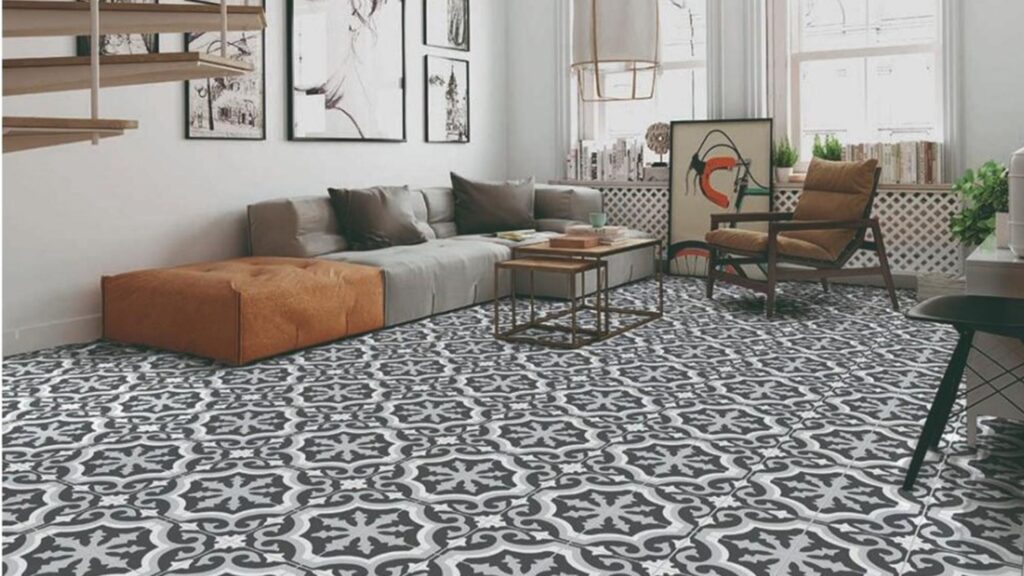
Can do it:
- Available in different colors, shapes, and finishes
- Easy to clean and maintain
- Water and stain-proof
Chippy and cracky - Crunchy and cold to walk on during extremely cold climatic conditions
2. Porcelain Floor Tiles
Porcelain tiles are ceramic tiles but are dense and technologically advanced. Porcelain tiles are more durable and more water-resistant than ceramic tiles, making them an excellent option among the different types of bathroom floor tiles.
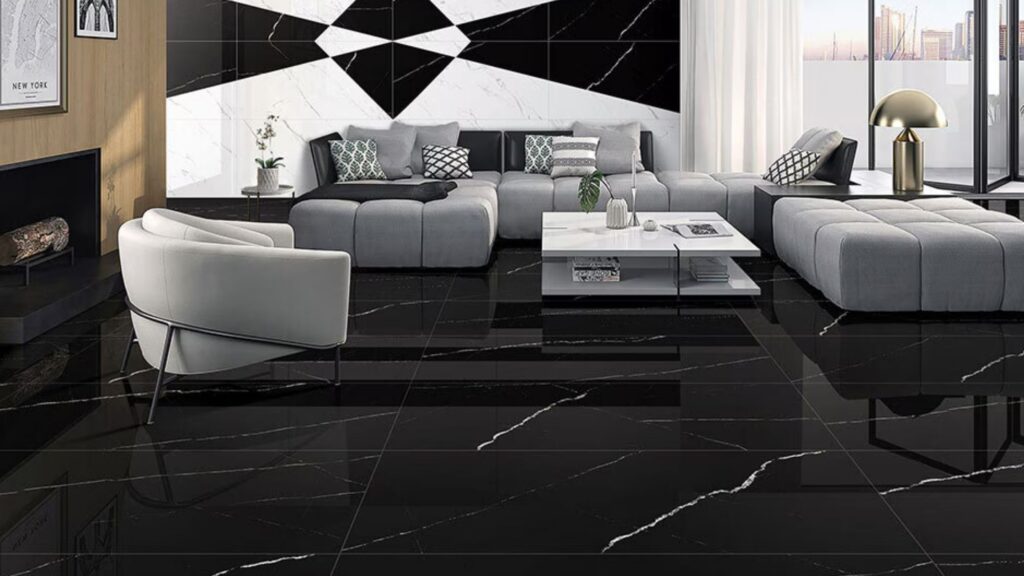
Benefits:
- Tough and scratchproof
- Long lasting for heavy wear and tear
- Easy maintenance
- Supports polished, matte, or textured finish
Limitations:
- Somewhat costly compared to standard ceramic tiles
- Heavy and dense, hard to install
3. Marble Flooring
The types of marble flooring are all about style and class. Marble tiles have the capability to give a living room a beautiful, long-lasting touch.

Benefits:
- Possesses its own beauty with distinctive veining patterns
- Boosts the value of the property
- Blinding spaces with shining surfaces create the effect of space and light in areas.
Limitations:
- Requires frequent sealant and upkeep
- Easily scratched and stain
- Most expensive compared to other floor varieties
4. Wood Flooring
Flooring that is wood delivers elegance and coziness to a living area. Wooden floor belongs to the categories of solid hardwood, engineered wood, or laminate wood types.
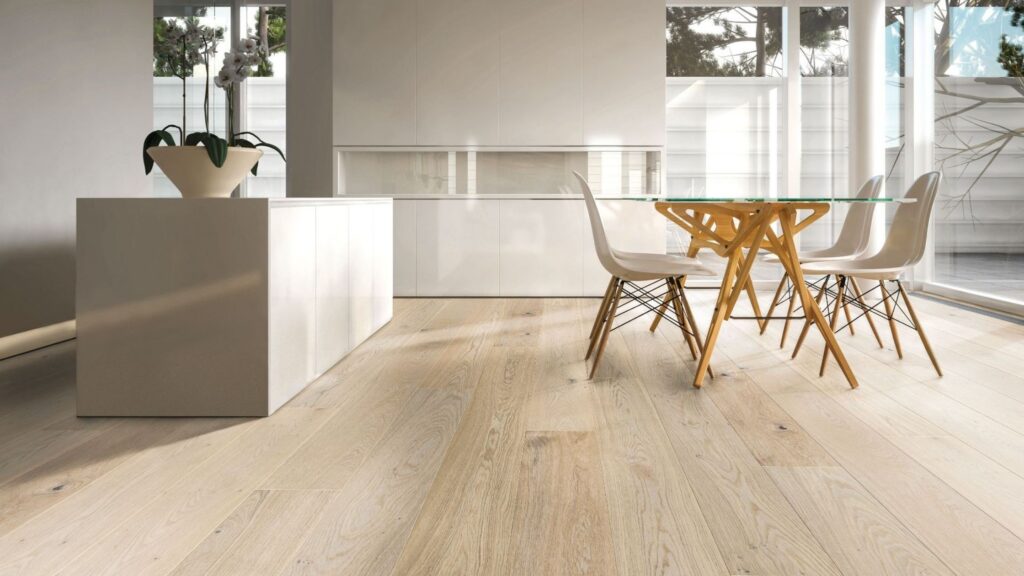
Pros:
- Elegant and organic appearance
- Warm and gentle to stroll over
- It may be refurbished multiple times
Cons:
- Easily damaged with water
- Requires regular maintenance
- Costly when compared to tile
5. Vinyl Flooring
Vinyl floor cover is quite common as it is not very costly and has existed for thousands of years. It imitates the look of wood, stone, or ceramic tile using a softer floor surface to step on.
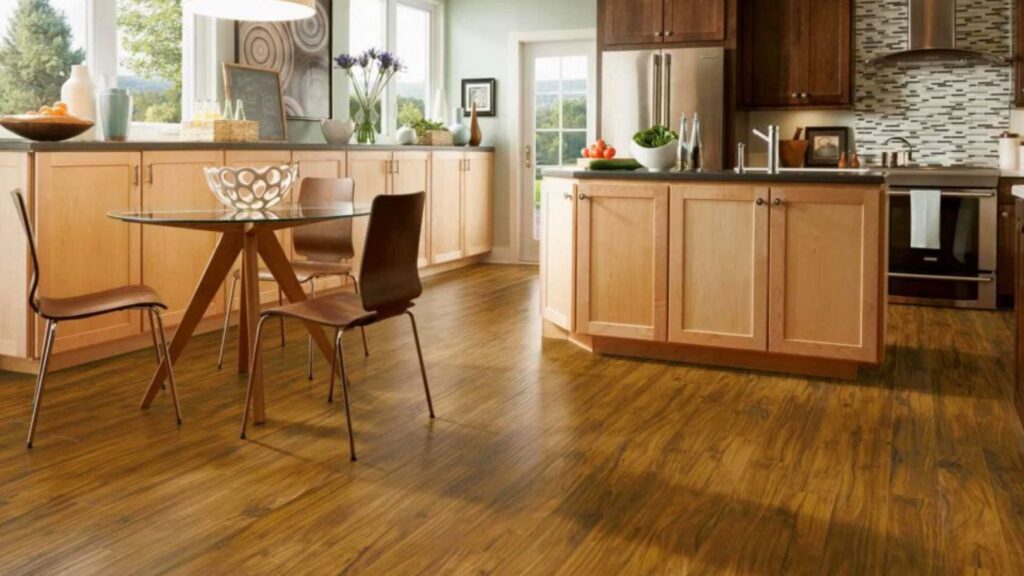
Benefits
- Waterproof and ideal for heavy-traffic spaces
- Cost-effective
- Peel-and-stick versions can be mounted easily
Disadvantages:
- Blanches with prolonged exposure to sunlight
- Less strong than ceramic tiles or stone
6. Granite Flooring
Granite is one of the hardest natural stones and thus very long-lasting for floors in the living room.
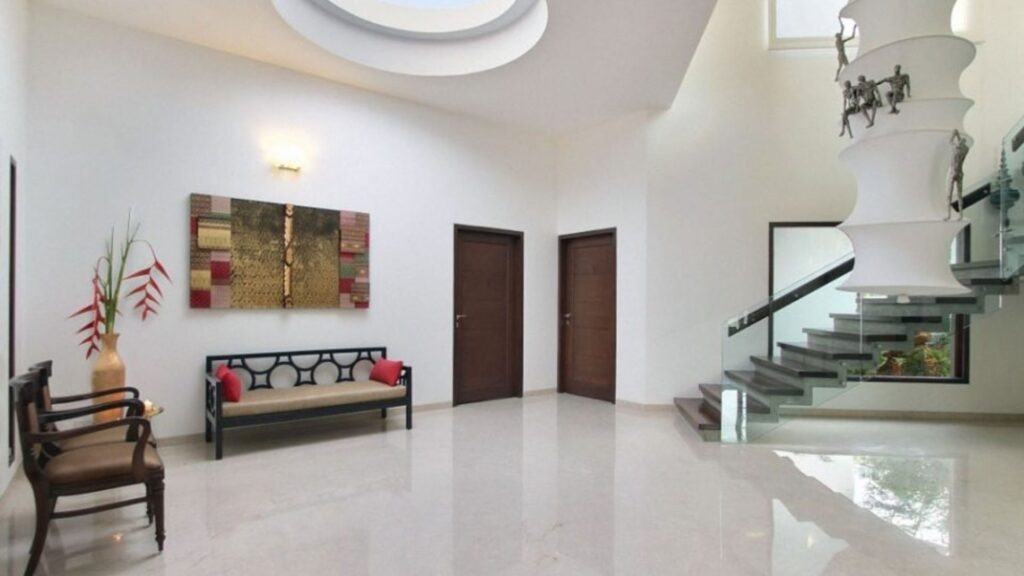
Pros:
- Extremely scratch-resistant and hard
- Heat- and moisture-resistant
- Matte and polished finishes
Cons:
- Slippery if polished
- Expensive professional installation
7. Terrazzo Flooring
Terrazzo is a blend of glass chips, marble, quartz, and granite.

Pros:
- Unique customizable designs
- Very resistant and long-lasting
- Environmentally friendly
Cons:
- Can be expensive
- Professional installation necessary
8. Concrete Flooring
Polished concrete flooring is great for the industrial or minimalist look.
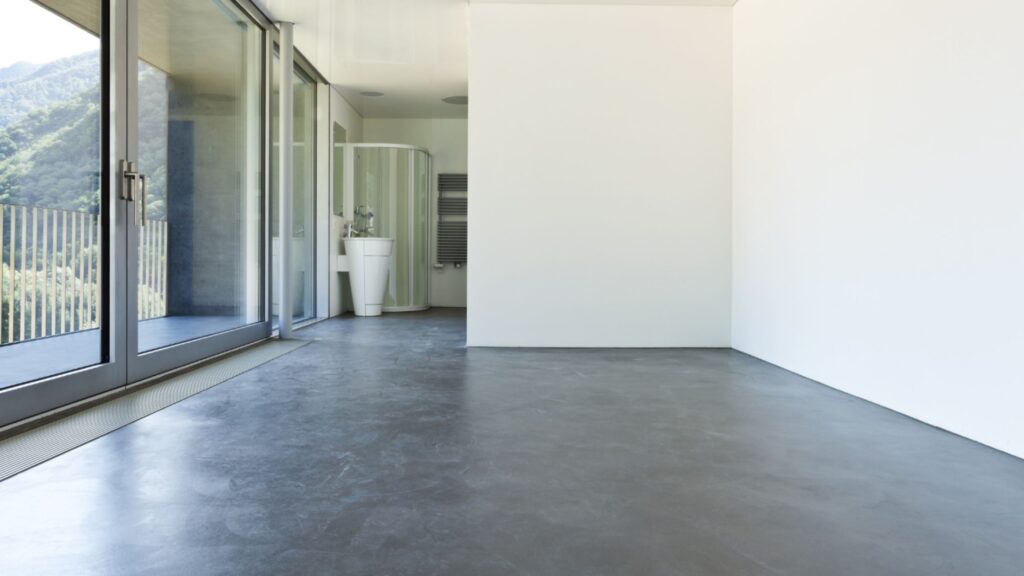
Pros:
- Sleek minimalist look
- Very low maintenance
- Very durable
Drawbacks:
- Cold and difficult to walk on
- It should be sealed to prevent staining
Types of Floor Finishes for Tiles in the Living Room
The finish you put on your floor dictates how your tiles appear and function. Some of the most popular finishes are:
- Glossy Finish: It reflects light and provides maximum brightness but is slippery.
- Matte Finish: Provides a natural look with improved slip resistance.
- Textured Finish: Provides grip and is ideal for preventing slips.
- Polished Finish: Shiny, smooth, and widely used on marble and granite floors.
A living room isn’t just about the flooring — a well-designed TV panel can also make a big difference. Check out Top TV Panel Design Ideas to Enhance Your Living Room for some creative and modern ideas.
How to Select the Perfect Floor Tiles for Your Living Room?
With the various choices of floor tiles, you may find it difficult to pick the best one. To guarantee that you pick the right one, here are some tips to consider:

1. Use Your Living Room Design
Your overall living room design should be your point of reference in making a selection of floor tiles. The floor is the overall mood setter of the entire design and, thus, must be in harmony with the furniture, wall paint, and room decor. Polished concrete or porcelain floor is just one of the options for a high-tech and sleek look.
The dull color and shiny finish give a modernistic look that will be perfect for industrial and minimalist designs. For ageless traditionalists who have a penchant for classic look which never goes out of style, wooden or marble flooring is excellent. The intrinsic patterns and surface texture give room depth and a sense of warmth.
For the lovers of rural or natural themes, terracotta tiles or natural stones could be employed. These surfaces have nature brought in, and a living room is not supposed to feel cold but warm and comfortable. Choose tiles that will complement your living room interior so that it is effortless and classy.
2. Keep in View Durability and Maintenance
Living room floor tiles are going to experience day-to-day usage, furniture movement, and occasional spillage. For a household with children or pets, durability becomes a necessity. Granite and porcelain are some of the most enduring scratch and stain-resistant tiles suitable for busybodies in the household.
The two are also resistant to fading and change of appearance even when they get old. The other types of flooring materials to be placed on the floors are always in need of constant maintenance. Marble, despite the fact that it may be high-tech and classy, is a porous stone and stains easily and thus always requires constant sealing as well as cleaning with such care.
Unsealed wood floors are maintenance-required, too, as they absorb water and warp or stain when liquid spills are not cleaned off. When you’re selecting floor tiles, consider your lifestyle as well and how much maintenance you can or will give. A low-maintenance floor will be convenient for you, save you energy and time, and be beautiful for your living room for a very, very long time.
3. Select tile shape and size carefully
The size and shape of floor tiles contribute significantly to the room feeling spacious and proportionate. Large-format tiles are highly desirable today since they provide the room with the illusion of spaciousness by reducing the number of grout lines. The smooth look will make the room appear larger and lighter. Alternatively, if you want something more intricate in design, then the application of small tiles can be utilized to create texture and depth in the floor.
A dramatic effect of a pattern or mosaic can be incorporated for visual interest, also serving as a focal point in the room. There is also yet another design advantage of having rectangular tiles where you can install these along one direction for stretching and spreading out the space.
For example, the use of rectangular tiles that are installed horizontally can stretch the narrow, longitudinal living room space, while vertical installation can assist in creating an illusion that the room is heightened in height. Understanding how shape and size affect the general sense of space will allow you to make the right decision when you’re deciding on the right types of floor tiles for living room.
4. Choose the Right Tile Finish
Your tile finish has both functional and aesthetic uses. Flat tiles would be suitable for someone who needs a natural look that’s also modest. They provide a gentle, non-glare finish that contributes to the coziness of a living room and provides them with slip resistance, ideal for families with children or the elderly. Gloss tiles are ideal for creating a bright, luxurious ambiance.
Their reflective quality has the ability to enhance a space’s ambient and artificial lighting and creates a pace that is more spacious and brighter. Gloss tiles are, however, slippery to tread, and should they be wet, they would thus not be so appropriate for houses with a lot of child and pet foot traffic. Texture tiles supply that blend between function and form.
They offer a second point of contact and are, therefore, a perfect solution for somebody who requires beauty and safety. The appropriate tile finish is a matter of keeping your floors gorgeous and suitable to your lifestyle.
While updating your floors, don’t forget about your walls! Get inspired by the Top 10 Latest Wall Designs for Bedrooms to create a stylish look throughout your home.
5. Keep in Mind the Cost and Budget
Prices of floor tiles vary based on material, quality, and brand. In advance, there should be a necessity to budget and determine the most cost-effective without compromising quality. Vinyl and ceramic tiles are some of the cheapest. They are easily available in numerous styles and colors and, thus, are the value-for-money choice for homeowners seeking trendy yet inexpensive flooring.
For homeowners willing to invest money in high-quality material, marble and granite tiles offer a luxurious look that makes a living room appear its best. They are expensive but pay back in the long run. For those who want a compromise between affordability and durability, porcelain tiles and engineered wood are the most affordable options.
They get to enjoy nature’s beauty without spending much and needing constant maintenance. Pitting your wallet against the weighing of value of each style allows you to choose flooring appropriate for your demands and budget requirements.
6. Consider Flooring Trends and Long-lasting Life
Floor trends come and go with the decades, but some of them are timeless trends. Beige, gray, and white never fall out of favor because they are neutral colors that provide any interior design with a shared foundation. They can be paired with any furniture and decor, and it is simple to replace them in the future.
Geometric and herringbone designs on tiles are trendier with contemporary homes. They add a unique and innovative touch to the space, which aesthetically pleases the living area with a visible presence. Besides looks, eco-friendly floor products are also on the hit list.
Contemporary homeowners are choosing green products such as bamboo, recycled wood, and natural stone tiles that make minimal environmental footprints. Holding dollars back to invest in floors that will benefit the existing trends and withstand the test of time will make a living room attractive and will do well in the long term.
Last Thoughts
The selection of the optimal available living room floor tile materials is prompted by looks, hardness, comfort, and price. You would desire the natural appearance of wood flooring, the elegance of marble, or the functionality of porcelain, each with its advantages. At Architects Casa, we help homeowners choose the right flooring material for their imagination. Browse through our range and transform your home with functional and beautiful floors. To get advice from experts, visit Architects Casa today and locate the best floor tiles for your home.
